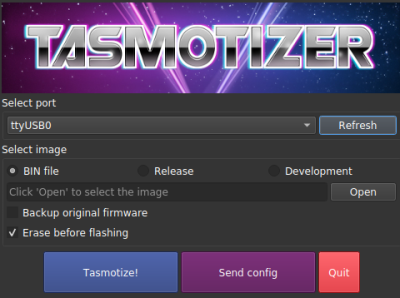 Tasmota is an alternative firmware for ESP boards that provides a wealth of handy features, and [Mat] has written up a guide to flashing with far greater ease by using Tasmotizer. Among other things, it makes it simple to return your ESP-based devices, like various Sonoff offerings, to factory settings, so hack away!
Tasmota is an alternative firmware for ESP boards that provides a wealth of handy features, and [Mat] has written up a guide to flashing with far greater ease by using Tasmotizer. Among other things, it makes it simple to return your ESP-based devices, like various Sonoff offerings, to factory settings, so hack away!
Tasmotizer is a front end that also makes common tasks like backing up existing firmware and setting configuration options like, WiFi credentials, effortless. Of course, one can’t really discuss Tasmotizer without bringing up Tasmota, the alternative firmware for a variety of ESP-based devices, so they should be considered together.
Hacks based on Sonoff devices are popular home automation projects, and [Mat] has also written all about what it was like to convert an old-style theromostat into a NEST-like device for about $5 by using Tasmota. A video on using Tasmotizer is embedded below, so give it a watch to get a head start on using it to hack some Sonoff devices.















Where’s the best place to obtain cheap sonoff devices?
Aliexpress or bangood
itead, the original makers of the devices
https://www.itead.cc/
If you live in Sweden they use some sort of drop shipping so you might not have to pay the post nord fee
Sonoff Tasmota supports so many devices that there’s no reason to necessarily buy Sonoff devices. Most of the smart outlets that that online bookstore sells can be flashed with Tasmota and only cost a little more. I prefer the devices that just have an outlet on them instead of splicing a device into a wire and there are several pages of them for sale.
I just took one of my Tasmota outlets which pumps into MQTT and into Node-Red and made it so when my phone is charging, it cuts the power to the outlet when the charging current drops below a set level. This only charges my phone to 92% which is plenty to get through the day and prolongs the life of the battery since it isn’t fully charged all night long.
Not sure if Hackaday ever posted this, but if you’re in the US, grab the $15 pack of Wyze plugs for flashing with Tasmota. They’re tough to open since they’re ultrasonically welded shut, and the UART pins are broken out to tiny little test pads, but they’re extremely cheap per unit if you buy a two pack at a big box store.
I superglued four header pins to the side of the output relays on mine, and soldered them to the TX-RX-GND-VCC pads with magnet wire, to make reflashing them in the future easier.
That sounds like more work and more money than getting a sonoff basic. I’m in Canada and I didn’t have a problem getting sonoff devices delivered from the official seller. But most importantly sonoff devices are usually held together with screws and have through hole programing headers
For outlets, I prefer buying tuya based plugs and using tuya convert to flash the plugs. Tuya convert is a script that exploits the update process of tuya based devices to flash tasmota.
Do you have a picture/video of the connections?
I watched the video and I am not really sure what this does besides back up what was on the device, which I would not be overwriting if I cared about, that the current crop of tools do not do. It still seems to sit on python, though it is apparently installed with it. Not that a new tool is bad, but what makes this so much nicer?
This is among the current crop of tools, isn’t it? So it does nothing that the current crop does not.
I think you need to imagine that you’re actually not familiar with any of the tools, and understand that this is an introduction to one of the most feature rich. Your comment currently reads like one of those “this iPhone is basically the same as the one I have, why should I upgrade?” comments. If you’re happy with what you have no one is going to come along and pry your firmware tool, or your iPhone, from your grasp.
Na, it is more like what I have works well and to date has not left me feeling like I have been missing anything. It is not prying anything from my grasp, but a simple question of what this does or what this does better than what is out there now. Someone else was kind enough to actually cover the differences as opposed to trying to belittle me for asking why one might want to change.
No need to prep your PC (install python and dependencies) no more memorising commands and pretty awesome template tool for custom ESP devices.
What it does… It saves you time
I think the hardest part of the flashing process is soldering. I wish Itead put common headers in its devices.
Don’t really need to solder. Just stick in a header. The fit is quite tight
New Sonoff R2 does not have gpio14 broken out, but this video shows where and how to get access to it.
https://youtu.be/K9qD48CCuBU
The new Sonoff R2 does not have gpio14 broken out, but here is a video showing where and how to get access to it.
https://youtu.be/K9qD48CCuBU
At first I thought someone had developed something easier than tuya-convert……but, wtf, you have to connect wires to flash the device?
Okay, I’ll stick to my Tuya-based devices. Yes, many years ago I was soldering together my own “smart plugs”, but nowadays I find it much more convenient to buy such devices on Amazon (with prices usually beating those on Aliexpress) and flash them via WiFi.